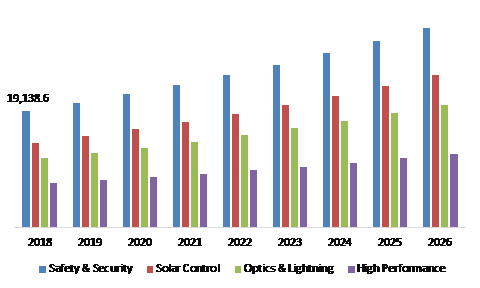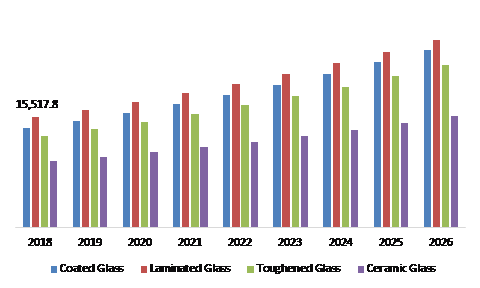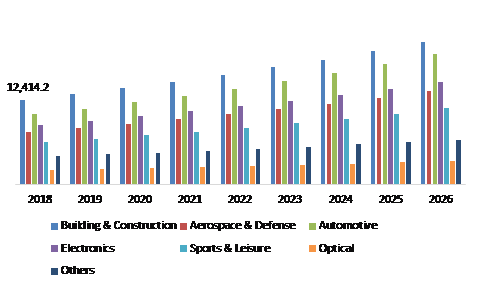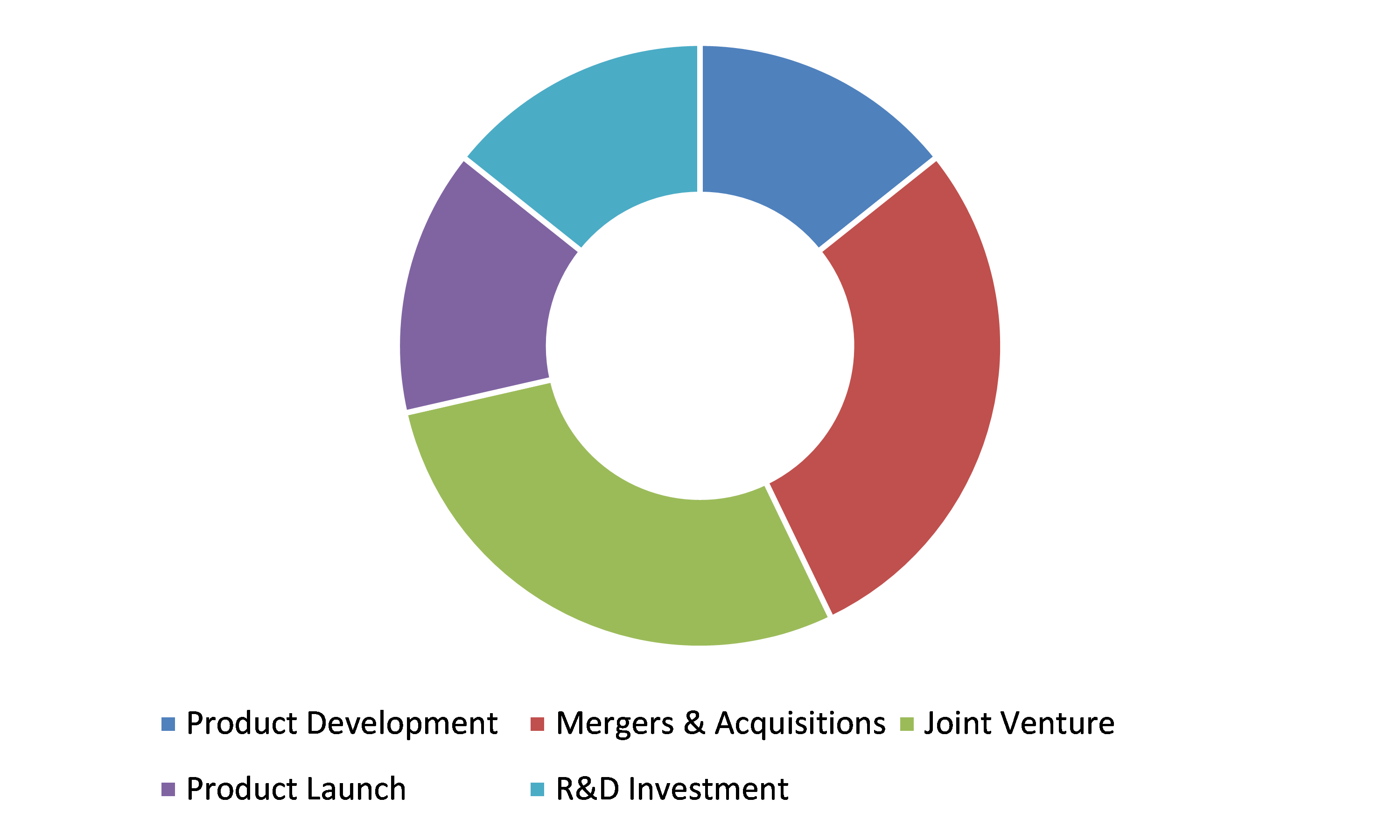Advanced Glass Market Report
RA00057
Advanced Glass Market, By Function (High Performance, Optics & Lighting, Safety & Security, Solar Control) By Product Type (Toughened Glass, Laminated Glass, Coated Glass, Ceramic Glass). End-Use (Aerospace & Defense, Automotive, Building & Construction, Electronics, Optical, Sports & Leisure, Others) Regional Analysis (North America, Europe, Asia Pacific, LAMEA) Global Opportunity Analysis and Industry Forecast, 2019–2026
Update Available On-Demand
Global Advanced Glass Industry Insights 2026:
The Advanced Glass Market forecast will be $ 90.21 Billion by 2026, growing from $ 51.72 Billion in 2018 at a healthy CAGR of 7.2%. Europe Market is projected to surpass $ 20.56 Billion by 2026. Asia Pacific region will have lucrative opportunities for the market investors to grow throughout the upcoming decades generate a revenue and expected to reach of $ 30.25 Billion by 2026.
Advanced glass is premium glass and particularly it is manufactured from component such as pure silica (Sio2, fused quartz), iron, natural gas, and sodium carbonate. It is a superior grade of glass designed with precise characteristics and provide multiple applications. Advanced glass comes with highly advanced techniques as it undergoes procedures such as chemical and mechanical processes. Due to its high quality and efficiency, advanced glass is used in several industries such as electronics and infrastructure.
Market Drivers:
Global acceptance for eco-friendly infrastructures coupled with extensive use in electronics and smart-homes sectors expected to boost the global market.
Rapidly growing adoption of advanced glass into construction industry is the significant factor which has compelled the demand for advanced glass all over the globe. Advanced glass is versatile product which has multiple applications such as noise cancellation, security, UV control and sound reduction which is also expected to fuel the growth advanced glass market, throughout the forecasted period. Moreover, rising adoption in automobile sector coupled with recent innovations in home appliances, electronic gadgets and smartphones’ screen protector eventually anticipated to drive the demand for advanced glass.
Market Restraints:
Shortage of raw materials coupled with high cost of advanced glass may hurdle the advanced glass market growth.
Unavailability of raw materials coupled with high cost of the advanced glass may hamper the demand and decline growth of the global market of advanced glass.
Industry Insight and Investment Opportunities:
Premium Glasses such as Bioactive Glass and Self-Cleaning glass are expected to create global opportunities for Advanced Glass Market
Market players are more focusing on cost-effective technologies that will improve energy efficiency along with increasing productivity of advanced glass market. Newly invented advanced glass market trends such as smart glass, thin glass, security glass, nano channel glass, bioactive glass and self-cleaning glass are expected to compel the global market. Moreover, key factors such as best practices initiatives, financial assistance and research and development of enabling technologies are expected to create enormous opportunities for the advanced glass industry around the globe.
Advanced Glass Market, by Function:
Solar control segment will be most lucrative till 2026

Source: Research Dive Analysis
Safety & security segment generated a revenue of $ 19,138.6 Million in 2018 and is expected to generate revenue of $ 32,837.4 Million by 2026. This is majorly due to this advanced glass has multifaceted and versatile applications for house windows and shopfronts.
Solar control segment generated a revenue of $ 13,966.0 Million in 2018 and is projected to generate revenue of $ 25,079.1 Million by 2026. This is majorly due to the developments in glass making industries which enhances on the reduction of heat generated by solar energy to get a good level of natural daylight. Therefore, rising popularity of luxury real estate segment will make positive impact on market of solar control glass.
Advanced Glass Market, by Product:
Laminated segment will register revenue of $26,522.5 million by 2026

Source: Research Dive Analysis
Laminated glass segment generated a revenue of $ 15,517.8 Million in 2018, and is expected to surpass $ 26,522.5 Million by 2026. The extensive growth in infrastructural development projects such as public transit systems and airports. Additionally, factors such as binding power, strength and durability are anticipated to foster the laminated glass market growth.
Advanced Glass Market system, by Application:
Building & construction segment will register revenue of $21,019.5 million by 2026 growing at healthy CAGR of 6.8%

Source: Research Dive Analysis
Building and construction segment generated a revenue of $ 12,414.2 Million in 2018, and is projected to surpass $ 21,019.5 Million by 2026.
Rapid growth in green constructions, energy efficient buildings, rapid growth in the population and increased incomes of people are expected to boost the building construction segment of advanced glass market.
Advanced Glass Market system, by Region:
Europe Advanced Glass Market Overview 2026:
Europe Market generated revenue of $ 11,379.7 Million in 2018, and is projected to surpass $ 20,568.5 Million by 2026. The significant usage of advanced glass in various application from automotive sector to electronics, expected to boost the advanced glass market. The automobile manufacturing sectors in the countries such as UK, Germany and France have grown extensively owing to supportive government policies. Also, government initiatives for energy efficiency and green constructions expected to boost the advanced glass market in Europe region.
Asia-Pacific Advanced Glass Market Outlook 2026
Asia Pacific region will have lucrative opportunities for the market investors to grow throughout the upcoming decades
Asia-Pacific market size will generate a revenue of $ 30,250.1 Million by 2026. The increasing demand for integrated advanced glass in countries such as Malaysia, China and India owing to significant growth in infrastructures and automotive industry. Rising emphasis of green buildings, along with the rapid development of the real estate market in emerging countries, is anticipated to provide potential growth for advanced glass market. Also, increasing investment by market players is estimated to have a major impact on the growth of advanced glass market.
Key participants and Recent Developments in global Advanced Glass Market:
Merger & acquisition and advanced product development are the frequent strategies followed by the market players

Source: Research Dive Analysis
Some of the major players of Advanced Glass Market include Advanced Glass & Mirror, Inc., Asahi Glass Co, PPG Industries, Saint Gobain, Nippon Sheet Glass Co. Ltd., Corning Inc., Sherwin Williams Company, Guardian Industries, Sisecam Group.
To gain competitive advantage, these companies investing heavily in the R&D activities to develop highly advanced glass. For instance, NSG (Nippon Sheet Glass Co. Ltd.) Group has increased the production capacity of the coated glass to support the market of solar energy.
Report Scope:
| Aspect | Particulars |
| Historical Market Estimations | 2018-2019 |
| Base Year for Market Estimation | 2018 |
| Forecast timeline for Market Projection | 2019-2026 |
| Geographical Scope | North America, Europe, Asia-Pacific, LAMEA |
| Segmentation by function |
|
| Segmentation by product |
|
| Segmentation by End-Use |
|
| Key Countries covered | U.S., Canada, Germany, France, Spain, Russia, Japan, China, India, South Korea, Australia, Brazil, and Saudi Arabia |
| Key Companies Profiled |
|
Source: Research Dive Analysis
Q1. What is the size of Advanced Glass Market system?
A. The global Advanced Glass Market system size was over $ 51,726.0 Million in 2018, and is projected to reach $ 90,212.5 Million by 2026.
Q2. Who are the leading companies in the Advanced Glass Market system?
A. Asahi Glass Co, Saint Gobain and Guardian Industries are some of the key players in the global Advanced Glass Market system.
Q3. Which region possess greater investment opportunities in the coming future?
A. Europe region possess great investment opportunities for the investors to witness the most promising growth in the coming years.
Q4. What is the growth rate of Europe market?
A. Europe Advanced Glass Market system is anticipated to grow at 7.7% CAGR during the forecast period.
Q5. What are the strategies opted by the leading players in this market?
A. Technological advancements, product development, along with joint ventures are the key strategies opted by the operating companies in this market.
Q6. Which companies are investing more on R&D practices?
A. Advanced Glass & Mirror, Inc., Corning Inc. Sherwin Williams Company companies are investing more on R&D activities for developing new products and technologies.
1. Research Methodology
1.1. Desk Research
1.2. Real time insights and validation
1.3. Forecast model
1.4. Assumptions and forecast parameters
1.4.1. Assumptions
1.4.2. Forecast parameters
1.5. Data sources
1.5.1. Primary
1.5.2. Secondary
2. Executive Summary
2.1. 360° summary
2.2. Function
2.3. Product type
2.4. End Use
3. Market overview
3.1. Market segmentation & definitions
3.2. Key takeaways
3.2.1. Top investment pockets
3.2.2. Top winning strategies
3.3. Porter’s five forces analysis
3.3.1. Bargaining power of consumers
3.3.2. Bargaining power of suppliers
3.3.3. Threat of new entrants
3.3.4. Threat of substitutes
3.3.5. Competitive rivalry in the market
3.4. Market dynamics
3.4.1. Drivers
3.4.2. Restraints
3.4.3. Opportunities
3.5. Technology landscape
3.6. Regulatory landscape
3.7. Patent landscape
3.8. Market value chain analysis
3.8.1. Stress point analysis
3.9. Strategic overview
4. Advanced Glass Market, by Function
4.1. High Performance
4.1.1. Market size and forecast, by region, 2016-2026
4.1.2. Comparative market share analysis, 2018 & 2026
4.2. Optics & Lighting
4.2.1. Market size and forecast, by region, 2016-2026
4.2.2. Comparative market share analysis, 2018 & 2026
4.3. Safety & Security
4.3.1. Market size and forecast, by region, 2016-2026
4.3.2. Comparative market share analysis, 2018 & 2026
4.4. Solar Control
4.4.1. Market size and forecast, by region, 2016-2026
4.4.2. Comparative market share analysis, 2018 & 2026
5. Advanced Glass Market, by Product
5.1. Toughened Glass
5.1.1. Market size and forecast, by region, 2016-2026
5.1.2. Comparative market share analysis, 2018 & 2026
5.2. Laminated Glass
5.2.1. Market size and forecast, by region, 2016-2026
5.2.2. Comparative market share analysis, 2018 & 2026
5.3. Coated Glass
5.3.1. Market size and forecast, by region, 2016-2026
5.3.2. Comparative market share analysis, 2018 & 2026
5.4. Ceramic Glass
5.4.1. Market size and forecast, by region, 2016-2026
5.4.2. Comparative market share analysis, 2018 & 2026
6. Advanced Glass Market, by End Use
6.1. Aerospace & Defense
6.1.1. Market size and forecast, by region, 2016-2026
6.1.2. Comparative market share analysis, 2018 & 2026
6.2. Automotive
6.2.1. Market size and forecast, by region, 2016-2026
6.2.2. Comparative market share analysis, 2018 & 2026
6.3. Building & Construction
6.3.1. Market size and forecast, by region, 2016-2026
6.3.2. Comparative market share analysis, 2018 & 2026
6.4. Electronics
6.4.1. Market size and forecast, by region, 2016-2026
6.4.2. Comparative market share analysis, 2018 & 2026
6.5. Optical
6.5.1. Market size and forecast, by region, 2016-2026
6.5.2. Comparative market share analysis, 2018 & 2026
6.6. Sports & Leisure
6.6.1. Market size and forecast, by region, 2016-2026
6.6.2. Comparative market share analysis, 2018 & 2026
6.7. Others
6.7.1. Market size and forecast, by region, 2016-2026
6.7.2. Comparative market share analysis, 2018 & 2026
7. Advanced Glass Market, by Region
7.1. North America
7.1.1. Market size and forecast, by function, 2016-2026
7.1.2. Market size and forecast, by product, 2016-2026
7.1.3. Market size and forecast, by end use, 2016-2026
7.1.4. Market size and forecast, by country, 2016-2026
7.1.5. Comparative market share analysis, 2018 & 2026
7.1.6. U.S.
7.1.6.1. Market size and forecast, by function, 2016-2026
7.1.6.2. Market size and forecast, by product, 2016-2026
7.1.6.3. Market size and forecast, by end use, 2016-2026
7.1.6.4. Comparative market share analysis, 2018 & 2026
7.1.7. Canada
7.1.7.1. Market size and forecast, by function, 2016-2026
7.1.7.2. Market size and forecast, by product, 2016-2026
7.1.7.3. Market size and forecast, by end use, 2016-2026
7.1.7.4. Comparative market share analysis, 2018 & 2026
7.1.8. Mexico
7.1.8.1. Market size and forecast, by function, 2016-2026
7.1.8.2. Market size and forecast, by product, 2016-2026
7.1.8.3. Market size and forecast, by end use, 2016-2026
7.1.8.4. Comparative market share analysis, 2018 & 2026
7.2. Europe
7.2.1. Market size and forecast, by function, 2016-2026
7.2.2. Market size and forecast, by product, 2016-2026
7.2.3. Market size and forecast, by end use, 2016-2026
7.2.4. Market size and forecast, by country, 2016-2026
7.2.5. Comparative market share analysis, 2018 & 2026
7.2.6. Germany
7.2.6.1. Market size and forecast, by function, 2016-2026
7.2.6.2. Market size and forecast, by product, 2016-2026
7.2.6.3. Market size and forecast, by end use, 2016-2026
7.2.6.4. Comparative market share analysis, 2018 & 2026
7.2.7. Spain
7.2.7.1. Market size and forecast, by function, 2016-2026
7.2.7.2. Market size and forecast, by product, 2016-2026
7.2.7.3. Market size and forecast, by end use, 2016-2026
7.2.7.4. Comparative market share analysis, 2018 & 2026
7.2.8. France
7.2.8.1. Market size and forecast, by function, 2016-2026
7.2.8.2. Market size and forecast, by product, 2016-2026
7.2.8.3. Market size and forecast, by end use, 2016-2026
7.2.8.4. Comparative market share analysis, 2018 & 2026
7.2.9. Italy
7.2.9.1. Market size and forecast, by function, 2016-2026
7.2.9.2. Market size and forecast, by product, 2016-2026
7.2.9.3. Market size and forecast, by end use, 2016-2026
7.2.9.4. Comparative market share analysis, 2018 & 2026
7.2.10. Rest of the Europe
7.2.10.1. Market size and forecast, by function, 2016-2026
7.2.10.2. Market size and forecast, by product, 2016-2026
7.2.10.3. Market size and forecast, by end use, 2016-2026
7.2.10.4. Comparative market share analysis, 2018 & 2026
7.3. Asia-Pacific
7.3.1. Market size and forecast, by function, 2016-2026
7.3.2. Market size and forecast, by product, 2016-2026
7.3.3. Market size and forecast, by end use, 2016-2026
7.3.4. Market size and forecast, by country, 2016-2026
7.3.5. Comparative market share analysis, 2018 & 2026
7.3.6. China
7.3.6.1. Market size and forecast, by function, 2016-2026
7.3.6.2. Market size and forecast, by product, 2016-2026
7.3.6.3. Market size and forecast, by end use, 2016-2026
7.3.6.4. Comparative market share analysis, 2018 & 2026
7.3.7. Japan
7.3.7.1. Market size and forecast, by function, 2016-2026
7.3.7.2. Market size and forecast, by product, 2016-2026
7.3.7.3. Market size and forecast, by end use, 2016-2026
7.3.7.4. Comparative market share analysis, 2018 & 2026
7.3.8. India
7.3.8.1. Market size and forecast, by function, 2016-2026
7.3.8.2. Market size and forecast, by product, 2016-2026
7.3.8.3. Market size and forecast, by end use, 2016-2026
7.3.8.4. Comparative market share analysis, 2018 & 2026
7.3.9. Australia
7.3.9.1. Market size and forecast, by function, 2016-2026
7.3.9.2. Market size and forecast, by product, 2016-2026
7.3.9.3. Market size and forecast, by end use, 2016-2026
7.3.9.4. Comparative market share analysis, 2018 & 2026
7.3.10. South Korea
7.3.10.1. Market size and forecast, by function, 2016-2026
7.3.10.2. Market size and forecast, by product, 2016-2026
7.3.10.3. Market size and forecast, by end use, 2016-2026
7.3.10.4. Comparative market share analysis, 2018 & 2026
7.3.11. Rest of the Asia Pacific
7.3.11.1. Market size and forecast, by function, 2016-2026
7.3.11.2. Market size and forecast, by product, 2016-2026
7.3.11.3. Market size and forecast, by end use, 2016-2026
7.3.11.4. Comparative market share analysis, 2018 & 2026
7.4. LAMEA
7.4.1. Market size and forecast, by function, 2016-2026
7.4.2. Market size and forecast, by product, 2016-2026
7.4.3. Market size and forecast, by end use, 2016-2026
7.4.4. Market size and forecast, by country, 2016-2026
7.4.5. Comparative market share analysis, 2018 & 2026
7.4.6. Brazil
7.4.6.1. Market size and forecast, by function, 2016-2026
7.4.6.2. Market size and forecast, by product, 2016-2026
7.4.6.3. Market size and forecast, by end use, 2016-2026
7.4.6.4. Comparative market share analysis, 2018 & 2026
7.4.7. Saudi Arabia
7.4.7.1. Market size and forecast, by function, 2016-2026
7.4.7.2. Market size and forecast, by product, 2016-2026
7.4.7.3. Market size and forecast, by end use, 2016-2026
7.4.7.4. Comparative market share analysis, 2018 & 2026
7.4.8. South Africa
7.4.8.1. Market size and forecast, by function, 2016-2026
7.4.8.2. Market size and forecast, by product, 2016-2026
7.4.8.3. Market size and forecast, by end use, 2016-2026
7.4.8.4. Comparative market share analysis, 2018 & 2026
7.4.9. Rest of LAMEA
7.4.9.1. Market size and forecast, by function, 2016-2026
7.4.9.2. Market size and forecast, by product, 2016-2026
7.4.9.3. Market size and forecast, by end use, 2016-2026
7.4.9.4. Comparative market share analysis, 2018 & 2026
8. Company profiles
8.1. Advanced Glass & Mirror
8.1.1. Business overview
8.1.2. Financial performance
8.1.3. Product portfolio
8.1.4. Recent strategic moves & developments
8.1.5. SWOT analysis
8.2. Asahi Glass Co
8.2.1. Business overview
8.2.2. Financial performance
8.2.3. Product portfolio
8.2.4. Recent strategic moves & developments
8.2.5. SWOT analysis
8.3. PPG Industries
8.3.1. Business overview
8.3.2. Financial performance
8.3.3. Product portfolio
8.3.4. Recent strategic moves & developments
8.3.5. SWOT analysis
8.4. Saint Gobain
8.4.1. Business overview
8.4.2. Financial performance
8.4.3. Product portfolio
8.4.4. Recent strategic moves & developments
8.4.5. SWOT analysis
8.5. Nippon Sheet Glass Co. Ltd.
8.5.1. Business overview
8.5.2. Financial performance
8.5.3. Product portfolio
8.5.4. Recent strategic moves & developments
8.5.5. SWOT analysis
8.6. Corning Inc.
8.6.1. Business overview
8.6.2. Financial performance
8.6.3. Product portfolio
8.6.4. Recent strategic moves & developments
8.6.5. SWOT analysis
8.7. Sherwin Williams Company
8.7.1. Business overview
8.7.2. Financial performance
8.7.3. Product portfolio
8.7.4. Recent strategic moves & developments
8.7.5. SWOT analysis
8.8. Guardian Industries
8.8.1. Business overview
8.8.2. Financial performance
8.8.3. Product portfolio
8.8.4. Recent strategic moves & developments
8.8.5. SWOT analysis
8.9. Sisecam Group
8.9.1. Business overview
8.9.2. Financial performance
8.9.3. Product portfolio
8.9.4. Recent strategic moves & developments
8.9.5. SWOT analysis
From automobiles to construction of huge buildings and from smart phones to everyday kitchen appliances, glass is an integral material that is extensively used. With various research & developments in the glass industry, scientists have invented an upgraded form of glass called ‘advanced glass’.
What is advanced glass?
Advanced glass is a superior grade of glass which is developed using natural gas, soda ash, and silica sand. This glass is manufactured using innovative techniques and technological substances, and can be used in various applications.
Advanced glass offers numerous benefits and applications such as UV control, sound reduction, safety, and security. It finds application in numerous industrial sectors such as construction, infrastructure, smartphones, automobiles, and electronics. Besides, it can be used as a screen protector in laptops and mobile phones.
Rising demand for advanced glass from various sectors
Nowadays, the construction sector is one the most rapidly evolving sector. This sector is seen to adopt several advanced materials for enhanced construction and better outcomes, and one among these materials is the use of advanced glass into various construction projects. Advanced glass is a multipurpose material which has numerous applications including security, noise cancellation, and UV control. Apart from the construction sector, this glass has seen increased usage in the automobile sector as well. Moreover, it is extensively used in various electronic gadgets, home appliances, and smartphones’ screen protector. Hence, considering the growing application of advance glass in various sectors, it is clear that the demand for advanced glass will definitely increase in the next few years.
Growing competition among advanced glass manufacturers
Several companies are now focusing on lucrative technologies that are expected to enhance the quality of glass and boost the output of advanced glass industry. Currently, advanced glass manufacturers are coming up with new varieties of advanced glass that are trending in the market. These varieties include security glass, Nano channel glass, smart glass, thin glass, bioactive glass, and self-cleaning glass. Nippon Sheet Glass Co. Ltd., one of the world’s largest manufacturers of glass and glazing products for the architectural, automotive, and technical glass sectors has amplified the production volume of the coated glass to fulfill the demands of the solar energy industry. Additionally, in 2019, it has declared a joint development contract between its subsidiary and Ubiquitous Energy, a frontrunner in transparent solar technology. Apart from Nippon Sheet Glass, there are various other companies currently dominating the advanced glass industry which include Asahi Glass Co, PPG Industries, Advanced Glass & Mirror, Inc., Saint Gobain, Sherwin Williams Company, Corning Inc., Guardian Industries, Sisecam Group, and others. These companies are greatly investing in research & developments activities and undertaking activities such as merges & collaborations, new product launches, and geographical inventions.
Future scope of advance glass industry
A report by Research Dive, states that the advanced glass sector is climbing the path of success by growing at a healthy growth rate of 7.2%. The automobile manufacturing industries in the countries such as UK, Germany and France are rapidly growing due to supportive government policies which is boosting demand for advanced glass in this sector. Moreover, steps taken by government for energy efficienct and eco-friendly constructions are likely to boost the advanced glass market in European region. Apart from Europe, Asia Pacific is another region which is expected to offer rewarding opportunities for the market investors and advanced glass manufacturers to expand their business in the upcoming years. Considering all these factors, it is clear that the market of advanced glass is paving its way toward development and is sure to gain heights in the coming future.
Personalize this research
- Triangulate with your own data
- Request your format and definition
- Get a deeper dive on a specific application, geography, customer or competitor
- + 1-888-961-4454 Toll - Free
- support@researchdive.com

